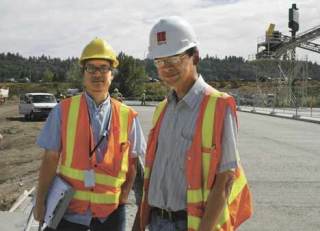City officials estimate that Kent will need to spend as much as $1.5 billion over the next 20 years on capital projects, with the lion’s share of nearly $1.2 billion going for for utilities and transportation.
City staff presented the 20-year plan for capital projects from 2009 to 2028 Aug. 19, during a City Council informational workshop at City Hall.
“It’s a plan,” John Hodgson, city chief administrative officer, told the Council. “Plans change based on revenues on hand, political environments and needs.”
Department heads from every division of the city were asked to look ahead to the next 20 years, in order to give city officials a better idea of how to plan for the future.
“This is an ideal,” Hodgson told the Council. “It sets us a plan. We can look at fees and see how drastic they might have to be. It’s a big number ($1.5 billion), but we can look at the long term and discuss it well beyond tonight.”
By looking so far into the future, city officials expect the 20-year plan to help with five-year planning for capital projects, as well as the planning that has begun for the 2009 budget.
“It’s been a good process for the departments to see the long-term issues,” Hodgson said.
Finding ways to pay for those projects will be a major challenge for city staff and the Council.
Sewer, storm drainage and water rates might have to be raised to an even higher percentage than previous increases to help pay for projects.
“The Council has been good about raising rates, but the increases have not kept pace with inflation,” Public Works Director Larry Blanchard said at the workshop.
An estimated $686 million will be needed for utility projects over the next 20 years to improve the city’s water, sewer and drainage systems. That includes $346 million for drainage projects, $273 million for water projects and $66 million for sewers.
An estimated $100 million of the drainage projects would go toward repairing the Green River levees in Kent to help protect the city from flooding.
City officials will try to lobby for federal grants to help pay for the levees, but many other cities from across the nation also are expected to go after funds to repair levees.
Existing utility revenues would bring in nearly $447 million over the next 20 years for capital improvements. The city would need an additional $200 million in new drainage fees to fund projects. Another $85 million would be needed to fund water projects.
City officials spent $466 million from 1998 to 2007 on all capital projects, said City Finance Director Bob Nachlinger. Nachlinger used that figure to help estimate the $1.5 billion the city would spend on projects over the next 20 years.
Transportation projects are estimated at $575 million from 2009 to 2028. About $300 million in new revenues would be needed to fund the transportation projects.
“We have about $350 million in revenue services,” Blanchard said. “We need another $250 million to $300 million for expansion and to add capacity.”
Among the most expensive street projects are the grade separation of streets from railroads. The current South 228th Street project to construct a roadway bridge over the railroad will cost an estimated $23 million. A similar proposal for the grade separation along Willis Street is estimated at $26 million.
The recently approved extension of South 224th Street up the East Hill will cost an estimated $25 million to $35 million.
Besides utilities and transportation, the other major capital projects over the next 20 years include $121 million for parks and recreation; $90 million for technology improvements and updates of city facilities; and $78 million for public safety.
Among the park projects would be $82 million for major improvements to neighborhood and regional parks and $22 million for a new aquatics facility. The Council has yet to decide whether it might send a property-tax measure to voters in 2009 to help pay for an aquatics center.
The public safety projects include an estimated $66 million for a new police headquarters, municipal court and fire station renovations, training-center improvements and a city-jail remodel.
Other unexpected projects could come up as well, causing priorities to change, Hodgson said.
“I appreciate what you’re doing,” Councilman Les Thomas told city staff at the workshop about the 20-year plan. “We have re-prioritized, but this is a goal to work toward.”
Talk to us
Please share your story tips by emailing editor@kentreporter.com.
To share your opinion for publication, submit a letter through our website https://www.kentreporter.com/submit-letter/. Include your name, address and daytime phone number. (We’ll only publish your name and hometown.) Please keep letters to 300 words or less.

